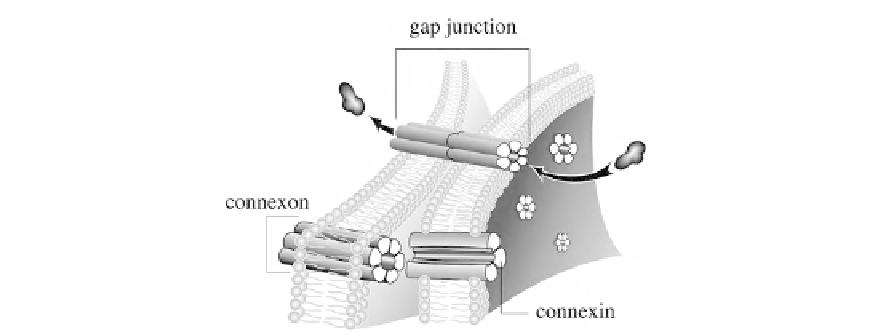Biology Reference
In-Depth Information
FIGURE 14.21
Gap junction
[43]
. Six connexins form a connexon and one connexon from each cell unite to form
a gap junction.
spread throughout the entire liver. Preventing this is one important function of Ca
2
þ
. Extra-
cellular Ca
2
þ
is ~10
3
M while intracellular levels are maintained at ~10
6
M. If a cell is
damaged, Ca
2
þ
rushes in, dramatically increasing intracellular Ca
2
þ
. Gap junction channels
close if intracellular Ca
2
þ
reaches 10
3
M, thus preventing the spread of damage.
Gap junctions are particularly important in cardiac muscle as the electrical signals for
contraction are passed efficiently through these channels
[45]
. As would be expected, mal-
functions of gap junctions lead to a number of human disorders including demyelinating
neurodegenerative diseases, skin disorders, cataracts, and even some types of deafness.
G. OTHER WAYS TO CROSS THE MEMBRANE
There are several other ways that solutes, including large macromolecules, can cross
membranes. These methods, receptor-mediated endocytosis (RME), phagocytosis, pinocy-
tosis, exocytosis, and membrane blebbing involve large sections of a membrane containing
many lipids and proteins.
Receptor Mediated Endocytosis
Receptor mediated endocytosis (RME)
[46,47]
is also known as clathrin-dependent endo-
cytosis because of involvement of the membrane-associated protein clathrin in forming
membrane vesicles that become internalized into the cell. Clathrin plays a major role in
formation of clathrin coated pits and coated vesicles. Since clathrin was first isolated and
named by Barbara Pearse in 1975
[48]
, it has become clear that clathrin and other coat-
proteins play essential roles in cell biology. Clathrin is an essential component in building
small vesicles for uptake (endocytosis) and export (exocytosis) of many molecules. While
the previously discussed methods of membrane transport involved small solutes, RME is
the primary mechanism for the specific internalization of most macromolecules by eukary-
otic cells.

